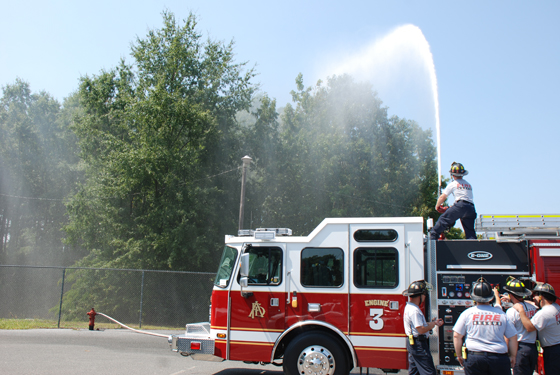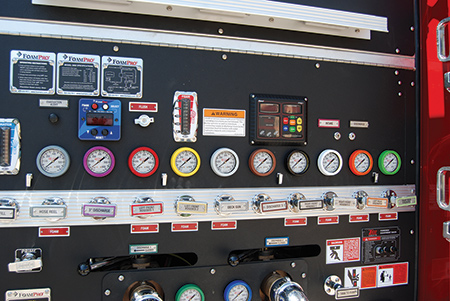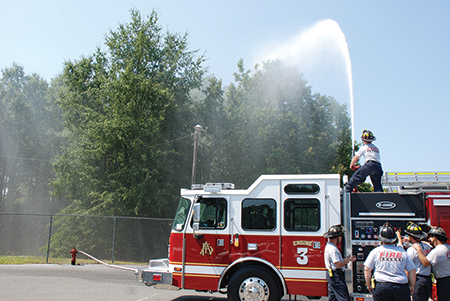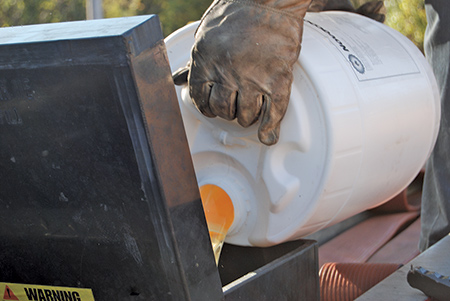
By Shawn Oke
The use of onboard foam delivery systems is becoming more and more common in our fire service.
The recent deliveries for the majority of fire apparatus manufacturers clearly show that fire departments are making the decision to add the very important capability to deliver an enhanced water stream (EWS) from their apparatus in a rapid manner. I say enhanced water stream rather than foam stream because a large number of fire service members considers foam as low- or medium-expansion aqueous film forming foam (AFFF). There are many more types of concentrates available to the fire service that will do much more than AFFF.
Being familiar with a few terms will pay dividends as you read this article and conduct research on onboard delivery systems and concentrates. Concentrate refers to what you generally get in a five-gallon bucket and mix with water to make foam. Concentrate is not foam; water mixed with concentrate and air makes foam. Solution refers to the mix of concentrate and water. Again, solution isn’t foam because it hasn’t had air introduced to it. Compressed air foam (CAF) is not a type of foam, such as AFFF or Class A. A compressed air foam system (CAFS) is a delivery system that is capable of making various consistencies of foam from dry to wet.
 |
| Consider the number of hoselines that will be enhanced water stream (EWS) capable. If your department is designing a delivery system to flow EWS, then design it that way. You should enable as many discharges to flow EWS as you possibly can. (Photos by author.) |
If your department has or is considering getting an onboard foam delivery system, there is a multitude of factors to consider to ensure you get an EWS when you expect one. The delivery system and the concentrate that will be used in that system are the two main areas we are going to focus on. Too often I have seen departments invest a great deal of time and research on the delivery system while forgetting to even look at the concentrate they will use with that system.
Delivery Systems
Let’s look at delivery systems and several factors you should consider to be sure you get your EWS when you need it. There are currently three common delivery systems purchased today: compressed air foam (CAF), injection, and eduction. Each type of system has advantages and disadvantages. Your department should conduct extensive research on these advantages and disadvantages to make a determination as to which system will best fit the department based on the research results and the department’s needs. It is important that cost not be the driving factor in deciding which delivery system to purchase. You need to be sure the advantages and disadvantages of the system are the deciding factors.
While conducting your research on the type of delivery system to use, there are some important factors to consider. Two of these factors are interdependent with the concentrate being used. You must know the maximum centipoise the delivery system can deliver and the concentrate’s centipoise. The centipoise of a liquid is the measure of its viscosity. In very basic terms, the viscosity of a liquid is its resistance to flow. The greater the viscosity, the slower the liquid will move. Temperature is very important regarding a liquid’s viscosity. The lower the temperature, the higher the viscosity. In other words, the colder it is, the slower the liquid will flow. This factor is very important if your department has large temperature swings or experiences very cold temperatures. A delivery system manufacturer should be able to give you the maximum centipoise its system will deliver. If it does not, be cautious. If the manufacturer doesn’t know the maximum centipoise that will work with its system, how will you know if your concentrate will work with that system?
 |
| Consider plumbing the deck gun to deliver EWS. If you have a fire big enough to require large flows, you want those large flows to be as effective as possible by enhancing them with your concentrate. |
In addition to knowing the maximum centipoise the system will deliver, you must know the maximum centipoise of the concentrate that will be used with the system. Obtain the concentrate’s viscosity from the manufacturer. It is very important to note what temperature the concentrate was when the viscosity was measured. Many manufacturers provide the viscosity of their concentrate at 77°F. If your department experiences temperatures below 77°F, the concentrate will have a higher viscosity than what the manufacturer reports. Use caution if your department experiences cold temperatures for long periods of time. The concentrate in your tank may thicken to the point that it will not perform with the delivery system.
The percentage of concentrate the system will deliver is also interdependent with the concentrate being used. The concentrates on the market today can be delivered from anywhere between 0.10 and six percent. There are systems capable of delivering concentrate within this range, and there are systems that only deliver set percentages or a small percentage range of concentrate. You need to know the concentrate’s manufacturer-recommended delivery percentage and be sure your delivery system can deliver that percentage. Consider future changes in the concentrate being used by your department. Your department might be using a one- to three-percent concentrate today. But as technology changes, you might decide to use a concentrate that needs to be delivered at 0.40 to 0.50 percent. If you purchase a system that only meets your current needs, you will be limited in your ability to change your concentrate in the future. You need to remember that your onboard delivery system has the same expected life as your apparatus. The concentrate you are using today may not be the concentrate you desire to use tomorrow.
Consider the maximum gallons per minute (gpm) of solution expected to be delivered. Many departments think of foam delivery systems as systems that will deliver a low-flow foam at a fuel spill or small Class B fire. If your department is forward thinking and uses an EWS for all fires, you need to be sure your delivery system can deliver the higher-solution flows that could be required at a commercial building fire or special hazards location within your jurisdiction. Be sure your system will give you the amount of solution you need.
 |
| Concentrate refers to what you generally get in a five-gallon bucket and mix with water to make foam. Concentrate is not foam; water mixed with concentrate and air makes foam. |
Consider the number of hoselines that will be EWS-capable. If your department is designing a delivery system to flow EWS, then design it that way. You should enable as many discharges to flow EWS as you possibly can. The ability to deliver an EWS from as many discharges as possible will allow the incident commander to make the decision on what discharges to use-not allow the system limitations to make that decision for him. Consider plumbing the deck gun to deliver EWS. If you have a fire big enough to require large flows, you want those large flows to be as effective as possible by enhancing them with your concentrate.
Give the concentrate tank’s size a great deal of thought. You want to be sure your concentrate tank is large enough to allow you to deliver enough solution to do the job. Consider the delivery percentage and total gallons of finished solution you want to deliver. If you are using a concentrate at three percent and have a 30-gallon concentrate tank, you are only going to be able to deliver 1,000 gallons of solution. If you are using a concentrate at 0.50 percent, that same 30-gallon tank of concentrate will give you 6,000 gallons of solution. Be careful to not limit your delivery system by not providing enough concentrate in the tank. If your department is using EWS for all fires, you want to be sure you have enough concentrate to handle the majority of the incidents you will encounter.
Filling the Tank
Consider a concentrate fill system. This system will allow the concentrate tank to be filled safely from the ground. I know many departments look at the concentrate fill system as an expensive add-on. If your department is going to use your delivery system on a regular basis, which it should, you will need to refill your concentrate tank on a regular basis. What would the cost be for the department if a firefighter falls from the top of the apparatus while trying to lift a heavy bucket of concentrate to pour it into the concentrate tank’s fill neck? What would the cost be to the firefighter who suffers a career-ending injury while trying to refill the concentrate tank from the top of the apparatus? If you are able to prevent one accident by adding the refill system, the investment you made will pay dividends to the department. Think about your personnel’s safety and welfare when you consider cutting the concentrate fill system from apparatus specifications.
 |
| The number of concentrates available to the fire service today is well over 30. Many different concentrates are available that do many different jobs and are delivered at a multitude of delivery rates. |
If you are purchasing a new fire apparatus compliant with National Fire Protection Association (NFPA) 1901, Standard for Automotive Fire Apparatus, you need to be familiar with this standard-in particular the chapter that governs installing and testing foam delivery systems. This chapter provides guidance to be sure the delivery system you are purchasing will work with the concentrate you are using. Ensuring compliance with this chapter will pay big dividends for your department. Be sure your apparatus manufacturer complies with all sections within this chapter.
Concentrate Selection
Once you have examined the concentrate delivery system, take a close look at the concentrate the system will be using. I have heard more than one department say, “Foam is foam, and all concentrates are the same-they make bubbles.” Those statements couldn’t be further from the truth. The number of concentrates available to the fire service today is well over 30. Many different concentrates are available that do many different jobs and are delivered at a multitude of delivery rates. Invest time in the concentrate just like the delivery system.
A great place to start your concentrate research is to read NFPA standards relating to concentrates: NFPA 18, Standard on Wetting Agents; NFPA 1150, Standard on Foam Chemicals for Fires in Class A Fuels; and NFPA 11, Standard for Low-, Medium-, and High-Expansion Foam. The appropriate NFPA standard will provide you with the testing criteria that the concentrate must undergo to be compliant. An understanding of the NFPA standards will allow you to interpret the information provided by the manufacturer on its product. These standards will provide you with a wealth of information relating to the characteristics and performance of the concentrates complying with the particular standard. Be sure you obtain and understand the appropriate NFPA standard for the concentrate you are using.
In addition to the NFPA standards, information relating to concentrates can be located within the Executive Fire Officer Applied Research Projects, which are available online through the National Fire Academy Learning Resource Center. During your research process, you should also talk with departments using the concentrate you are using. These agencies can provide you with pros and cons they have experienced. There is no need to experience the same pitfalls other departments have already experienced. Take the time to learn from the experiences of others.
When choosing a concentrate, it is important to examine the hazards being protected by that concentrate. If your department will be primarily protecting Class A materials, consider using a concentrate designed to extinguish Class A fires. If your department will be primarily protecting Class B fuels, consider using a concentrate designed primarily for those fuels. NFPA 18-compliant wetting agents are an excellent choice for departments that will be using their concentrate on Class A and Class B fuels. Do not be fooled into thinking all bubbles are the same and can handle any fire. You must know the capabilities of your concentrate. All concentrates are not created equal and do not perform in the same manner.
Concentrate Purchasing
Although cost shouldn’t be the determining factor, it is important. When pricing concentrates, it is important that you do not focus solely on the concentrate’s price. You should determine and focus on the solution price to be sure you are comparing apples to apples. An example is a concentrate that is applied at one percent and costs $15 per gallon vs. a concentrate that is applied at 0.40 percent and costs $30 per gallon. When you first look at the example, you are inclined to believe the $15-per-gallon concentrate is the best deal. But when you look at the amount of solution each concentrate will deliver, the $30-per-gallon concentrate is a better deal. The one-percent concentrate will use one gallon of concentrate to deliver 100 gallons of solution at a cost of $15. The 0.40 percent concentrate will use 0.40 gallons to deliver the same 100 gallons of solution for the cost of $12. Although the $15-per-gallon concentrate is initially half the purchase price of the comparison concentrate, the required flow rate is higher, which will result in a higher finished foam cost for your department than the $30-per-gallon concentrate. Be sure you take the time to determine the finished foam cost of any concentrate before you purchase it.
Prior to purchasing a concentrate, obtain all available documentation from the manufacturer on its product. If the concentrate you are considering purchasing is NFPA 18 compliant, you should request that the manufacturer provide you with copies of its independent certification agency testing documentation. This documentation will provide you with the results of performance testing the concentrate underwent to meet the standard. The NFPA 18 classification documentation will provide you with valuable performance data on the concentrate. This performance data is vital in deciding if the concentrate you are considering performs to your expectations.
When making decisions about your delivery system, it is important to realize how interrelated your decisions are. Here are a few examples to consider. If you are using a concentrate at a three-percent delivery rate and only put a 10-gallon concentrate tank on the apparatus, you don’t need to spec a delivery system capable of delivering a high-gpm flow of solution, as this scenario will only produce a total of 330 gallons of solution. On the contrary, if you use a concentrate at a 0.40-percent delivery rate with a 40-gallon concentrate tank and put a delivery system only capable of delivering a few hundred gpm of solution or only have one or two lines equipped to deliver solution, you are spending money on a system that won’t be used as it is intended. You need to be sure all of the components of your delivery system are compatible with each other.
Purchasing an onboard foam delivery system isn’t as simple as saying “I want foam.” To be sure you are spending your money wisely and designing a system that will meet the needs of your community for the future, you must take your time and do your research. The time and effort that you invest today will pay dividends for your community for the life of your apparatus. Please take the time to become educated about your delivery system and concentrate so you can make effective decisions for your community.
SHAWN OKE is a 25-year veteran and chief of the Albemarle (NC) Fire Department. He has a bachelor’s degree in fire engineering technology from the University of North Carolina Charlotte. He completed the National Fire Academy Executive Fire Officer Program. Oke serves as an at-large member of the IAFC Safety, Health, and Survival Section board of directors. He is the co-founder of the Kill the Flashover project, where he has been involved in extensive wetting agent research.

